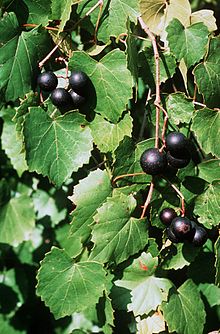Vitis rotundifolia
| Muscadine | |
|---|---|

| |
| Scientific classification | |
| Kingdom: | Plantae |
| Clade: | Tracheophytes |
| Clade: | Angiosperms |
| Clade: | Eudicots |
| Clade: | Rosids |
| Order: | Vitales |
| Family: | Vitaceae |
| Genus: | Vitis |
| Subgenus: | Vitis subg. Muscadinia |
| Species: | V. rotundifolia
|
| Binomial name | |
| Vitis rotundifolia Michx. | |
Vitis rotundifolia, or muscadine,
Muscadine berries may be bronze or dark purple or black when
In a natural setting, muscadine provides wildlife habitat as shelter, browse, and food for many birds and animals.[2] It is also a larval host for the Nessus Sphinx Moth (Amphion floridensis) and the Mournful Sphinx Moth (Enyo lugubris).[7]
Taxonomy and pathology
Although in the same genus Vitis with the other grapevine species, the muscadine species belongs to a separate subgenus, Muscadinia (all other grapevine species belong to subgenus Euvitis). Usually the species is divided into three varieties, Vitis rotundifolia Michx. var. rotundifolia (southeast USA), Vitis rotundifolia Michx. var. munsoniana (Florida), and Vitis rotundifolia Michx. var. popenoei (Central America).[8] Some taxonomists have suggested giving the muscadines standing as a separate genus. It has also been suggested that the muscadine varieties be upgraded to species rank and so splitting off Vitis munsoniana and Vitis popenoei from Vitis rotundifolia. All muscadines have 40 chromosomes, rather than 38, are generally not cross-compatible with Euvitis subgenus, and most hybrids between the subgenera are sterile. A few are moderately fertile, and have been used in breeding. A commercially available Euvitis × Muscadinia hybrid is the Southern Home cultivar.[9][2]
Although muscadines are hearty grapes with tough skin that protects them from many
Cultivars

There are about 152[11] muscadine cultivars grown in the Southern states.[12] These include bronze, black and red varieties and consist of common grapes and patented grapes.[13]
Unlike most cultivated grapevines, many muscadine cultivars are
Muscadine grape cultivars may have low or inconsistent yields, small berries, flavor and thick skin unsuitable to consumer acceptance, and disease susceptibility.[2] Cultivars tend to be developed either for a limited fresh market or for winemaking.[2] For consumer acceptance, fresh market grapes need to be large, sweet, and with relatively thin skin, whereas those for wine, juice or jelly need high yields of high-sugar, color-stable berries.[2]
Fresh-market cultivars include Black Beauty, Carlos, Cowart, Flowers, Fry, Granny Val, Ison, James, Jumbo, Magnolia, Memory (first found on T.S. Memory's farm in 1868 in Whiteville, NC), Mish, Nesbitt, Noble, Scuppernong, Summit, Supreme, and Thomas.[2][13][14] Produced by the University of Florida, the cultivar, 'Southern Home', contains both subgenera Muscadinia and Euvitis (more precisely, V. rotundifolia × V. vinifera) in its background.[2][9]
Crops can be started in 3–5 years. Commercial yields of 20–45
Appellations

Appellations producing Muscadine wines:[16]
- America (Country Appellation)
- Alabama (State Appellation)
- Arkansas (State Appellation)
- Florida (State Appellation)
- Georgia (State Appellation)
- Louisiana (State Appellation)
- Mississippi (State Appellation)
- North Carolina (State Appellation)
- South Carolina (State Appellation)
- Tennessee (State Appellation)
- Texas (State Appellation)
Nutrients
100 grams of muscadine grapes contain the following nutrients according to the USDA:[15]
- Energy: 57 kilocalories
- Fats: 0.47 g
- Carbohydrates: 13.93 g
- Dietary Fiber: 3.9 g
- Protein: 0.81 g
- Calcium: 37 mg
- Phosphorus: 24 mg
- Potassium: 203 mg
- Sodium: 1 mg
- Vitamin C (total ascorbic acid): 6.5 mg
- Riboflavin: 1.5 mg
Consumer research
Resveratrol and other polyphenols

One report indicated that muscadine grapes contained high concentrations of resveratrol,[18] but subsequent studies have found no or little resveratrol in muscadine grapes.[6]
Other muscadine
The rank order of total phenolic content among muscadine components was found to be seeds, higher than skins, higher than leaves, higher than pulp.[6]
References
- ^ USDA, NRCS (n.d.). "Vitis rotundifolia". The PLANTS Database (plants.usda.gov). Greensboro, North Carolina: National Plant Data Team. Retrieved 6 August 2015.
- ^ a b c d e f g h Peter C. Andersen; Timothy E. Crocker; Jacque Breman (2018). "The muscadine grape". Institute of Food and Agricultural Sciences, University of Florida. Retrieved 27 September 2019.
- ^ Biota of North America Program 2014 county distribution map
- ^ "Profile for Vitis rotundifolia (muscadine)". PLANTS Database. USDA, NRCS. Retrieved October 18, 2011.
- ISBN 1-56164-372-6.
- ^ PMID 12926904.
- ^ "Muscadine, Muscadine grape". Natives for your Neighborhood.
- ^ Norbert Tischelmayer: Vitis rotundifolia. On: glossary.wein.plus
- ^ .
- .
- ^ "Muscadine: Vitis International Variety Catalog". Julius Kühn-Institut - Federal Research Centre for Cultivated Plants. Retrieved 7 February 2018.
- ^ a b "Muscadine Grape Breeding Program: General Information". Muscadine Grape Breeding Program: General Information. University of Georgia College of Agricultural and Environmental Sciences. Archived from the original on 7 September 2015. Retrieved 11 October 2015.
- ^ PMID 27542461.
- ^ Growing Muscadine Grapes in Oklahoma
- ^ a b "America's First Grape – The Muscadine". United States Department of Agriculture. November 1997.
- ^ "Appellations Growing Muscadine Grapes". Appellation America. Retrieved 2007-12-01.
- PMID 27741360.
- S2CID 98822789.
- PMID 12009984.
- PMID 16028988.
External links
- The Muscadine Experience: Adding Value to Enhance Profits 2004 – 80 page technical resource for growers and processors, University of Arkansas
